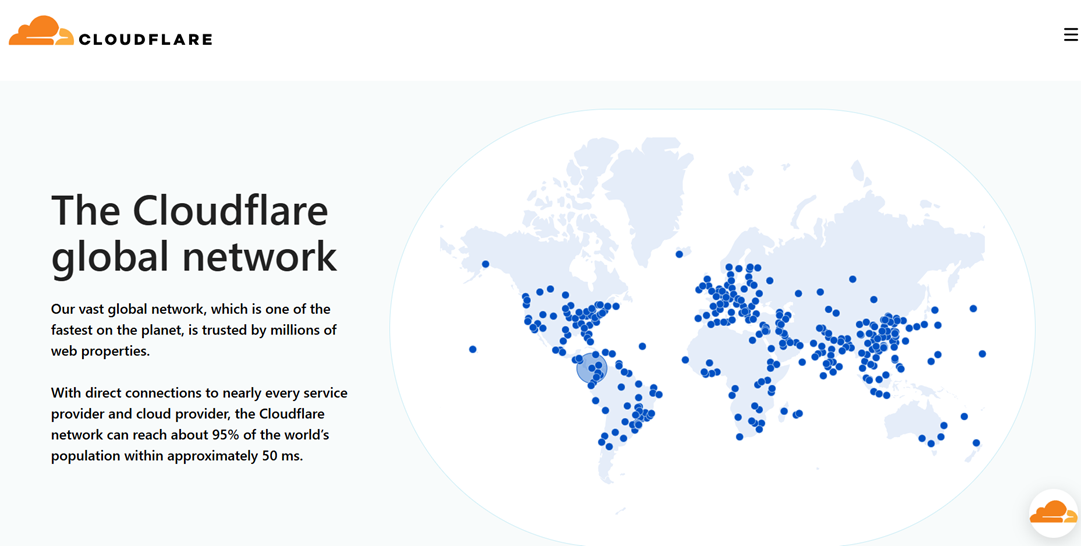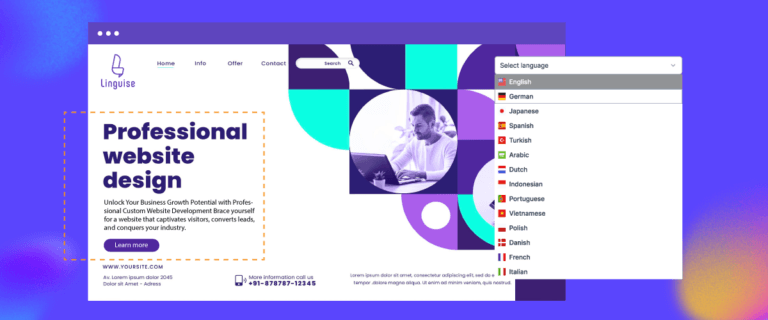When a website attracts visitors from different countries, performance and accessibility often become a concern. International WordPress hosting offers a solution by providing infrastructure designed to handle global traffic efficiently while keeping loading times and security stable across regions.
This hosting approach supports scalability and localization simultaneously, ensuring that users from various countries can access content quickly, in their preferred language, and in compliance with local regulations. It also helps businesses maintain consistent quality by expanding their reach to new markets.
Why global brands need international WordPress hosting?

Expanding a website globally requires a hosting solution that performs well in different regions. Here’s why international WordPress hosting is so important for global brands.
- Consistent performance worldwide – Server networks distributed across regions reduce latency, ensuring fast loading speeds for users, no matter where they access the site.
- Improved SEO in multiple regions – Localized hosting locations help search engines identify regional relevance, improving rankings in country-specific search results.
- Regulatory compliance and data protection – Hosting in regional data centers supports compliance with local privacy laws such as GDPR or PDPA, keeping user data safe and lawful.
- Localized user experience – Combining hosting with language and regional settings ensures users receive content that feels native, boosting engagement and trust.
- Scalability for global growth – As traffic from multiple countries increases, scalable hosting makes it easy to expand server capacity without downtime or performance drops.
Scalability strategies for global WordPress hosting

Managing a WordPress site for an international audience requires a hosting foundation capable of handling traffic surges, maintaining fast loading speeds across regions, and ensuring stability under varying network conditions. This section explores key strategies for building a resilient, flexible, growth-ready infrastructure supporting global expansion.
Scalable server architecture
A scalable server architecture is the backbone of international WordPress hosting. Using load balancing and elastic resources, websites can distribute incoming traffic evenly across multiple servers in different locations. This ensures that users in Europe, Asia, and the Americas experience equally fast performance, even during sudden traffic spikes.
Cloud-based hosting platforms such as AWS, Google Cloud, and DigitalOcean enable this flexibility with auto-scaling capabilities that adjust resources automatically based on demand. This is especially vital for global brands running large-scale campaigns or seasonal events that cause significant traffic fluctuations.
Localized CDN and edge networks
A Content Delivery Network (CDN) plays a major role in accelerating page load times worldwide. Caching content on “edge” servers closer to users, access times are drastically reduced, minimizing latency and ensuring fast delivery regardless of geography. This allows visitors from Japan to Brazil to enjoy the same seamless browsing experience without relying on a single data center.
Modern CDN providers such as Cloudflare, Akamai, or Fastly offer regional optimizations, including dynamic caching and intelligent routing based on local network conditions. This enhances performance and strengthens security with distributed DDoS protection across multiple network points.
To better understand how a global network supports scalability, the map below illustrates how CDN Cloudflare and edge servers are distributed worldwide. These distributed nodes ensure users receive content quickly, no matter where they are.

Regional integrations

Regional integrations allow websites to adapt to local infrastructure and business requirements. For example, using payment gateways like Stripe in the U.S., Razorpay in India, or Midtrans in Indonesia ensures smooth transactions without compatibility issues. Similarly, integrating compliance plugins such as GDPR tools or cookie consent banners is crucial for meeting local legal requirements.
Building these integrations requires a modular and flexible approach to WordPress development. By leveraging APIs and region-specific plugins, businesses can enable or adjust functionalities per market without disrupting the system, ensuring a seamless and consistent user experience worldwide.
Migration and troubleshooting
Migrating from a single-location setup to a multi-region architecture can be complex. Maintaining data integrity, plugin compatibility, and database structure requires careful planning. A staging environment is highly recommended so teams can test thoroughly before pushing changes live across all regions.
Additionally, having a failover and automated backup strategy is essential. With such systems in place, traffic can instantly reroute to another region if one server goes down, minimizing downtime for end users. This proactive approach helps maintain reliability, especially for businesses with high traffic and global reach.
Data residency and compliance management
Operating across borders means adhering to local data privacy and residency regulations such as the GDPR in Europe or PDPA in Southeast Asia. For instance, data from European users must remain within the EU unless transferred under a recognized legal framework.
In WordPress environments, this can be managed by choosing hosting providers with data centers in multiple regions and support for localized data segmentation. With proper configuration, companies can ensure regulatory compliance while maintaining optimal performance in every market they serve.
Performance testing and global consistency
Global performance testing ensures a website remains fast and responsive regardless of user location. Tools like GTmetrix, Pingdom, and WebPageTest allow teams to test site speed from multiple regions and identify improvement areas.
Beyond speed testing, load testing is equally important for simulating real-world traffic surges. By conducting such tests, site administrators can detect potential bottlenecks before they affect real users, preserving a consistent, high-quality experience for audiences worldwide.
The dashboard below is an example of GTMetrix web testing that can be used for testing. You can enter a link, select the region and browser you want to use, and the results will show how load times can vary between global locations and highlight the importance of continuous performance monitoring.

Localization strategies for seamless global experiences

Once scalability is established, the next challenge for global WordPress hosting is localization, ensuring that every visitor feels like the website was built for them. This involves adapting not just the language, but also the content, layout, and experience based on cultural expectations and local behavior. Below are key strategies to create a truly localized experience for global users.
Geo-targeting and personalization
Geo-targeting allows websites to detect a user’s location and automatically deliver the most relevant version of content. For example, a visitor from France might see prices in euros and local shipping options, while someone from Japan might be directed to the Japanese-language version of the site. This level of personalization makes global websites feel native, increasing engagement and conversion rates.
WordPress can achieve this effectively with tools like Linguise translation, which combines automatic language detection and high-quality neural translation to deliver localized content instantly. Businesses can also personalize CTAs, banners, and product recommendations based on regional preferences, for instance, promoting summer collections in Australia while showing winter deals in Canada.
Regional SEO and analytics
Each country has its own dominant search engine and user behavior, which means SEO efforts must be localized. While Google is prevalent globally, markets like China and Russia rely on Baidu and Yandex. Optimizing for these platforms involves adapting metadata, keywords, and structured data to meet their algorithms’ standards.
Analytics must also reflect these regional differences. Configuring tools like Google Analytics 4 or Matomo to segment traffic by country or language helps identify how users in different regions interact with the site. For example, analyzing bounce rates and session durations per region can uncover UX issues specific to certain languages or markets.
Seamless international user experiences

A seamless international experience means users can browse, purchase, or interact with content without friction, regardless of location. This requires consistent performance, clear navigation, and localized content that feels natural to each audience. For example, ensuring that checkout pages automatically switch to local currency and preferred payment methods reduces cart abandonment significantly.
To achieve this, many global WordPress sites rely on translation plugins like Translation integrated with multilingual design frameworks. Combining these with geolocation tools and language fallback options ensures users are never stuck on untranslated pages or confusing interfaces.
Performance consistency
Even with localization, maintaining consistent speed and responsiveness across regions is critical. Users expect pages to load quickly whether they’re in Singapore or São Paulo. Variations in latency or content delivery can negatively impact trust and conversion.
Performance consistency can be maintained through region-aware caching and distributed hosting. For instance, pairing a localized CDN with image optimization tools like ShortPixel or Jetpack Boost ensures visuals load quickly everywhere. Monitoring uptime across data centers also helps detect and address region-specific slowdowns before users notice them.
Cultural and UX adaptation

Cultural adaptation goes beyond translation, it’s about understanding how users from different regions perceive design, color, and messaging. For example, red symbolizes prosperity in China but can imply danger in Western contexts. Similarly, reading direction and typography preferences vary across cultures.
UX adaptation means designing layouts that respect these cultural nuances. A WordPress site targeting Middle Eastern users might use right-to-left (RTL) text alignment, while one for Japan could emphasize minimalist layouts. Adapting imagery, tone, and call-to-action phrasing helps brands connect authentically with each audience.
Monitoring and optimization
Localization is never “done”, it requires ongoing monitoring to stay relevant and effective. Regularly reviewing performance, translation accuracy, and conversion metrics per region helps identify where improvements are needed. For instance, an underperforming landing page in Germany might indicate a translation that doesn’t fully align with local tone or idioms.
Optimization tools such as A/B testing, heatmaps, and session recordings can provide insight into how users interact with localized versions. Adjustments based on this data, from button placement to content tone , help fine-tune the experience and improve engagement globally.
User feedback and continuous localization
User feedback is one of the most valuable inputs for improving localized experiences. Encouraging visitors to rate translations or suggest better terminology ensures that language evolves naturally alongside audience expectations. Feedback loops can also reveal usability issues that analytics might miss, such as unclear forms or mistranslated CTAs.
Many brands implement in-page feedback widgets or multilingual surveys using tools like Hotjar or Typeform. By combining user insights with analytics data, global WordPress sites can continuously refine localization quality, creating an experience that feels local, personal, and trustworthy across all regions.
Conclusion
International WordPress hosting is the foundation of a truly global digital presence, combining performance, security, and localization into one cohesive infrastructure. By leveraging scalable architecture, localized CDNs, and compliance-ready data management, global brands can ensure seamless access and consistent quality for users worldwide. Beyond performance, effective localization transforms a multilingual website into an authentic, culturally relevant experience that builds trust and engagement across borders.
For brands looking to simplify and enhance their multilingual strategy, Linguise Translation offers a powerful solution. Its real-time neural translation and automatic language detection make localization effortless, ensuring your content resonates with audiences worldwide. Try Linguise and experience how easy it is to make your WordPress site global.




